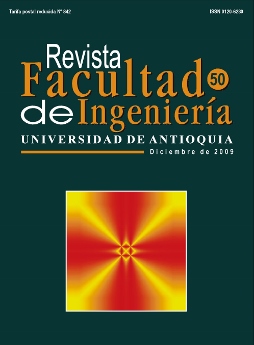Algoritmo de votación incremental INC-ALVOT para clasificación supervisada
DOI:
https://doi.org/10.17533/udea.redin.14945Palabras clave:
Clasificación supervisada, algoritmos de votación, algoritmos incrementalesResumen
En este trabajo, se presenta un algoritmo incremental para clasificación supervisada llamado INC-ALVOT (algoritmo de votación incremental). Este algoritmo permite manejar conjuntos de datos mezclados, los cuales no se almacenan en la memoria principal. Además, el algoritmo permite incorporar nuevos objetos en el conjunto de datos inicial, realizando un número mínimo de operaciones para la clasificación de nuevos objetos con el conjunto de datos expandido. Se presentan los resultados obtenidos al aplicar el algoritmo propuesto en diversos conjuntos de datos reales comparado con el algoritmo clásico de votación ALVOT.
Descargas
Citas
J. F. Martínez Trinidad, A. Guzman Arenas. “The logical combinatorial pattern recognition an overview through selected works”. Pattern Recognition. Vol. 34. 2001. pp. 741-751. DOI: https://doi.org/10.1016/S0031-3203(00)00027-3
J. Ruiz Shulcloper, M. Lazo Cortés. “Mathematical algorithms for the supervised classification based on fuzzy partial precedence”. Mathematical and Computer Modeling. Vol. 29. 1999. pp. 111-119. DOI: https://doi.org/10.1016/S0895-7177(99)00044-8
E. López Espinoza, J. Carrasco Ochoa, J. F. Martinez Trinidad. “Two floating search strategies to compute the suppot sets system for ALVOT”. Proc. CIARP 2004. LNCS. Ed. Springer-Verlag. Puebla (México). 2004. pp. 677-684. DOI: https://doi.org/10.1007/978-3-540-30463-0_85
J. Carrasco Ochoa, J. F. Martínez Trinidad. “Editing and training for ALVOT, an evolutionary approach”. Proc. IDEAL 2003. LNCS. Ed. Springer-Verlag. Hong Kong. 2003. pp. 452-456. DOI: https://doi.org/10.1007/978-3-540-45080-1_61
Y. Moyao Martinez. Programa paralelo para el cálculo del sistema de conjuntos de apoyo del algoritmo de clasificación CR+. Tesis de Maestría en Ciencias de la Computación. BUAP. Puebla. México. 1998. pp. 1-32.
D. Aha, D. Kibler, M. Albert. “Instance-based learning algorithms”. Machine learning. Vol. 6. 1991. pp. 37-66. DOI: https://doi.org/10.1007/BF00153759
J. Carrasco Ochoa. Sensibilidad en el enfoque lógico combinatorio de patrones. Tesis de Doctorado en Ciencias de la Computación. CIC-IPN. México. 2001. pp. 10-70.
A. Pons Porrata, G. Sánchez Díaz, M. Lazo Cortés, L. Alfonso Ramírez. “An incremental clustering algorithm base don compact set with radius α”. Proc. CIARP 2005. LNCS. Ed. Springer-Verlag. La Habana (Cuba). 2005. pp. 518-527. DOI: https://doi.org/10.1007/11578079_54
G. Sánchez Díaz, J. Ruíz Shulcloper. “A clustering method for very large mixed data sets”. Proc. IEEEICDM 01. San José (CA). 2001. pp. 643-644.
J. Ruíz Shulcloper, A. Guzmán Arenas, J. Martínez Trinidad. Enfoque lógico combinatorio al reconocimiento de patrones. Serie avances en reconocimiento de patrones. Edit. Instituto Politécnico Nacional. México. 1999. pp. 59-75.
.M. Lazo Cortés, J. Ruíz Shulcloper, E. Alba Cabrera. “An overview of the evolution of the concept of testor”. Pattern Recognition. Vol. 34. 2001. pp. 753- 762. DOI: https://doi.org/10.1016/S0031-3203(00)00028-5
A. Asunción, D. J. Newman. “UCI repository of machine learning databases http://www.ics.uci.edu/~mlearn/MLRepository.html. Consultada el 11 de octubre de 2008. Irvine. CA: University of California. Department of information and computer science. 1998. pp. 1-1.
M. H. Dunham. Data Mining. Introductory and Advances Topics. Ed. Pearson Education Inc. New Jersey. 2003. pp. 3-20.
Descargas
Publicado
Cómo citar
Número
Sección
Licencia
Derechos de autor 2018 Revista Facultad de Ingeniería

Esta obra está bajo una licencia internacional Creative Commons Atribución-NoComercial-CompartirIgual 4.0.
Los artículos disponibles en la Revista Facultad de Ingeniería, Universidad de Antioquia están bajo la licencia Creative Commons Attribution BY-NC-SA 4.0.
Eres libre de:
Compartir — copiar y redistribuir el material en cualquier medio o formato
Adaptar : remezclar, transformar y construir sobre el material.
Bajo los siguientes términos:
Reconocimiento : debe otorgar el crédito correspondiente , proporcionar un enlace a la licencia e indicar si se realizaron cambios . Puede hacerlo de cualquier manera razonable, pero no de ninguna manera que sugiera que el licenciante lo respalda a usted o su uso.
No comercial : no puede utilizar el material con fines comerciales .
Compartir igual : si remezcla, transforma o construye a partir del material, debe distribuir sus contribuciones bajo la misma licencia que el original.
El material publicado por la revista puede ser distribuido, copiado y exhibido por terceros si se dan los respectivos créditos a la revista, sin ningún costo. No se puede obtener ningún beneficio comercial y las obras derivadas tienen que estar bajo los mismos términos de licencia que el trabajo original.










 Twitter
Twitter